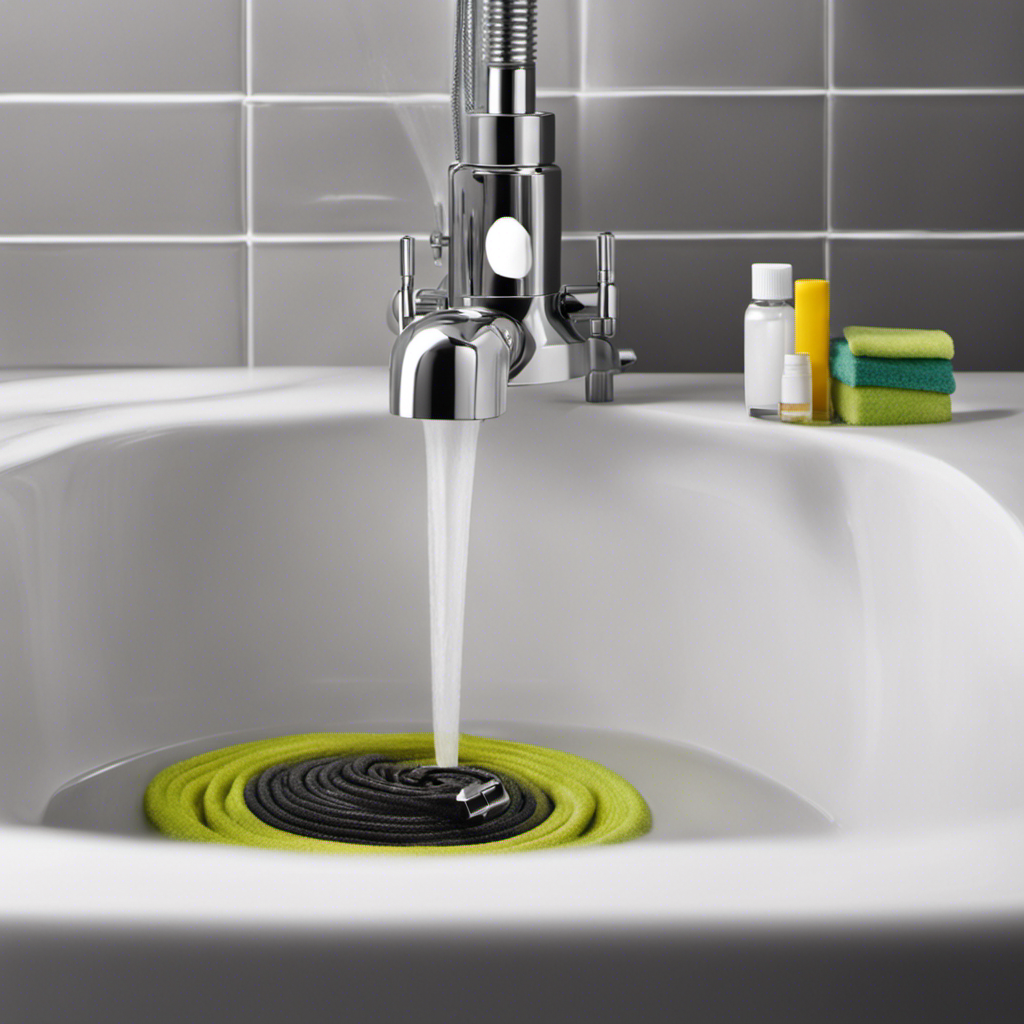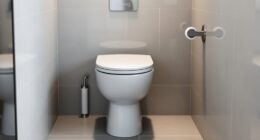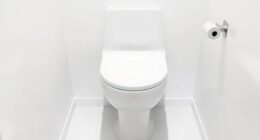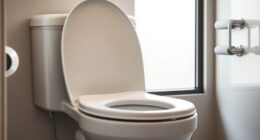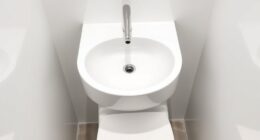Have you ever been in a foreign country, frantically looking for the restroom? We’ve all experienced it.
In this article, we’ll show you how to confidently ask, ‘Where is the bathroom?’ in Spanish. Whether you’re traveling to a Spanish-speaking country or simply want to expand your language skills, we’ve got you covered.
With our helpful tips and phrases, you’ll never have to worry about finding the bathroom again.
So let’s get started!

Key Takeaways
- "¿Dónde está el baño?" and "Necesito ir al baño" are common phrases to ask for the location of the bathroom and to express the need to use it.
- Look for signs such as "Baños" or "Servicios" to find the bathroom, or ask locals for directions.
- Respect cultural differences in bathroom etiquette and follow any guidelines or rules that may be in place.
- Understand common bathroom signs in Spanish such as "Caballeros" (Men’s restroom), "Damas" (Women’s restroom), and "Aseo" (Unisex restroom).
Basic Bathroom Vocabulary
Where do we find the basic bathroom vocabulary in Spanish?
When it comes to mastering the language, it’s essential to have a solid foundation in Spanish bathroom vocabulary. Knowing the right words and phrases won’t only help you navigate through everyday life situations but also ensure effective communication in the bathroom.
Some important phrases for using the bathroom in Spanish include:
- ‘¿Dónde está el baño?’ (Where is the bathroom?)
- ‘Necesito ir al baño’ (I need to go to the bathroom)
- ‘¿Hay papel higiénico?’ (Is there toilet paper?)
Additionally, it’s crucial to be familiar with words like:

- ‘inodoro’ (toilet)
- ‘lavabo’ (sink)
- ‘ducha’ (shower)
Asking for Directions to the Bathroom
To find the bathroom in Spanish, we typically ask someone, ‘Could you please tell us how to get to the bathroom?’ When traveling in different Spanish-speaking cities, it’s important to know how to ask for directions to the bathroom. Here are some tips to help you navigate this situation:
- Look for signs: In many cities, public restrooms are marked with signs that say ‘Baños’ or ‘Servicios.’ Keep an eye out for these signs to easily locate the bathroom.
- Ask locals: If you can’t find a sign or you’re unsure of the location, don’t hesitate to ask a local for directions. Most people are happy to help and will guide you to the nearest restroom.
- Respect cultural differences: Keep in mind that bathroom etiquette can vary across different cultures. Be mindful of local customs and follow any guidelines or rules that may be in place.
Common Phrases to Use in the Bathroom
Once we’ve successfully located the bathroom, we can now familiarize ourselves with essential bathroom phrases in Spanish.
It’s important to be aware of cultural differences in bathroom etiquette when traveling to Spanish-speaking countries.
One common phrase is ‘¿Dónde está el baño?’ which means ‘Where is the bathroom?’

When asking for toilet paper, you can say ‘¿Dónde está el papel higiénico?’
To ask for soap, you can say ‘¿Dónde está el jabón?’
It’s also polite to know how to say ‘Excuse me’ in case the bathroom is occupied. In Spanish, you can say ‘Perdón’ or ‘Disculpe.’
Understanding these common phrases will help us navigate the bathroom with ease.

Now, let’s move on to understanding bathroom signs in Spanish.
Understanding Bathroom Signs in Spanish
Now that we’re familiar with essential bathroom phrases in Spanish, let’s explore the topic of understanding bathroom signs in Spanish.
When navigating public restrooms in Spanish-speaking countries, it’s important to understand the various signs you may encounter. Here are three common bathroom signs and what they mean:
- ‘Caballeros’ – This sign depicts a man and indicates the men’s restroom. In Spanish bathroom customs, it’s common to see separate facilities for men and women.
- ‘Damas’ – This sign features a woman and signifies the women’s restroom. Similar to many other cultures, Spanish bathroom etiquette involves separate facilities for men and women.
- ‘Aseo’ – This sign is non-gender specific and represents a unisex restroom. In some places, unisex restrooms are becoming more common as a way to promote inclusivity and accommodate individuals who may not identify with traditional male or female genders.
Understanding these bathroom signs will help you navigate public restrooms in Spanish-speaking countries and respect local customs and etiquette.

Additional Tips for Bathroom Etiquette in Spanish-speaking Countries
Often, we find it helpful to familiarize ourselves with the customs and etiquette of bathroom use in Spanish-speaking countries. Understanding Spanish bathroom customs can help us navigate unfamiliar situations and show respect to the local culture. There are some cultural differences in bathroom etiquette that are important to note. In many Spanish-speaking countries, it is customary to throw toilet paper in the trash bin instead of flushing it down the toilet. Additionally, it is common for public restrooms to have attendants who provide toilet paper and maintain cleanliness. It is polite to tip these attendants for their services. Finally, it is important to remember that some countries may have separate facilities for men and women, while others may have unisex bathrooms. By being aware of these customs, we can ensure a positive bathroom experience while respecting the local culture.
| Spanish Bathroom Customs | Cultural Differences in Bathroom Etiquette |
|---|---|
| Throwing toilet paper in the trash bin | Flushing toilet paper down the toilet |
| Tipping restroom attendants | No tipping |
| Separate facilities for men and women | Unisex bathrooms |
Frequently Asked Questions
How Do I Say "Toilet Paper" in Spanish?
Toilet paper in Spanish is "papel higiénico." When asking for directions to the bathroom in Spanish, you can use phrases like "¿Dónde está el baño?" or "¿Puede indicarme dónde está el servicio?"
Can You Provide a List of Common Bathroom Phrases Used in Latin American Countries?
Sure, we can provide a list of common bathroom phrases used in Latin American countries. We can also tell you the different words for ‘bathroom’ in various Latin American countries and how to ask for directions to the bathroom in Spanish.
What Are Some Polite Ways to Ask for Toilet Paper if It Is Not Available in the Bathroom?
If there’s no toilet paper in the bathroom, we can politely ask for it by saying, "Excuse me, could you please provide some toilet paper?" In some cultures, alternative methods for cleaning oneself are available.

Are There Any Cultural Customs or Etiquette I Should Be Aware of When Using Public Bathrooms in Spanish-Speaking Countries?
In Spanish-speaking countries, it’s important to be aware of proper bathroom hygiene practices and cultural customs. Additionally, bidets are commonly used in Latin American bathroom culture, so it’s good to familiarize ourselves with their significance.
Is It Common for Public Bathrooms in Spanish-Speaking Countries to Have Separate Facilities for Men and Women?
In Spanish-speaking countries, public bathrooms often have separate facilities for men and women. However, there is a growing trend towards gender neutral bathrooms to promote inclusivity and accessibility for all individuals.
Conclusion
In conclusion, learning basic bathroom vocabulary in Spanish is essential for travelers. Asking for directions to the bathroom and understanding common phrases will greatly assist in navigating unfamiliar surroundings.
Additionally, being able to interpret bathroom signs will prevent any embarrassing or confusing situations. Remember, proper bathroom etiquette is important in Spanish-speaking countries. So, don’t forget to say ‘¡Hola!’ to the señor or señora cleaning the facilities.





